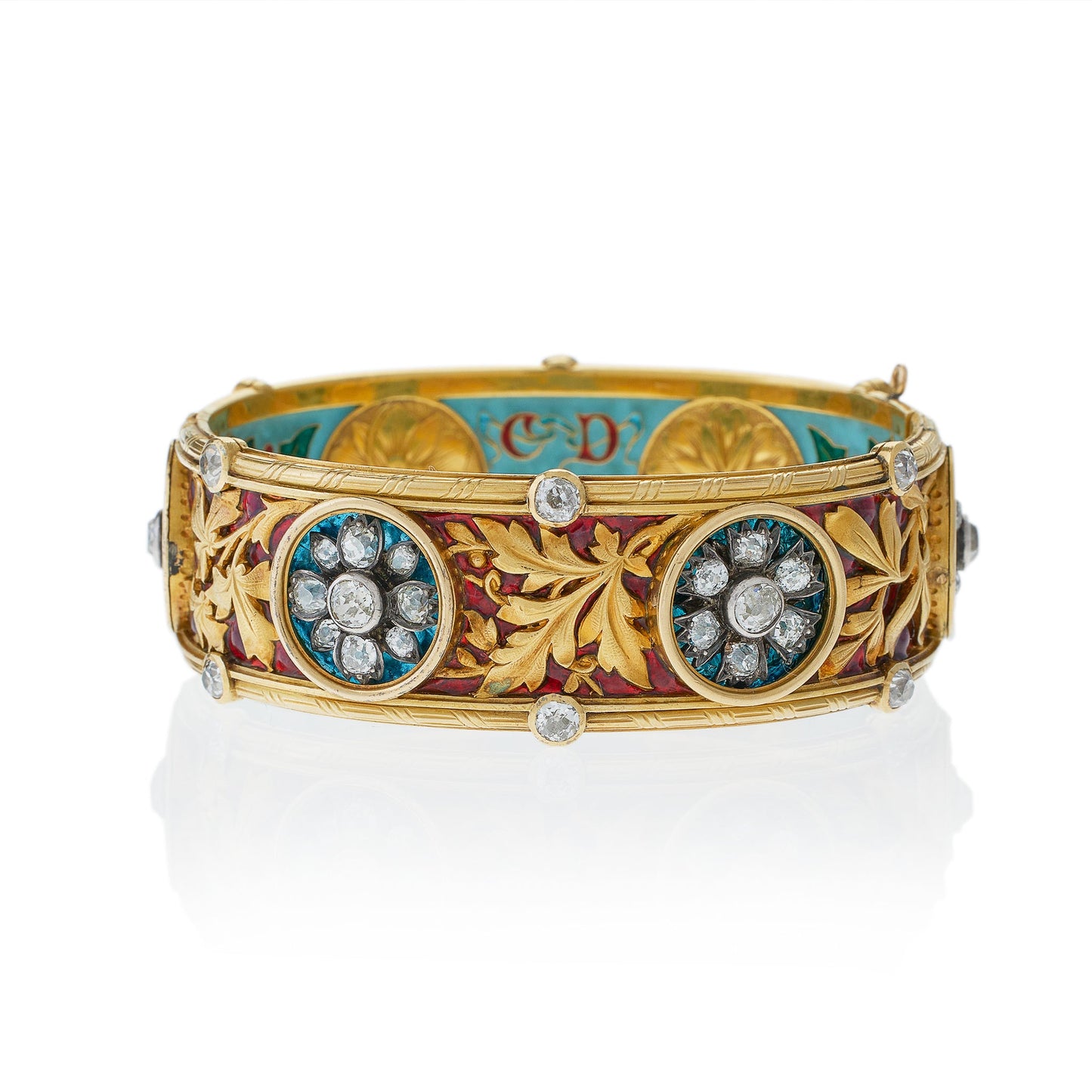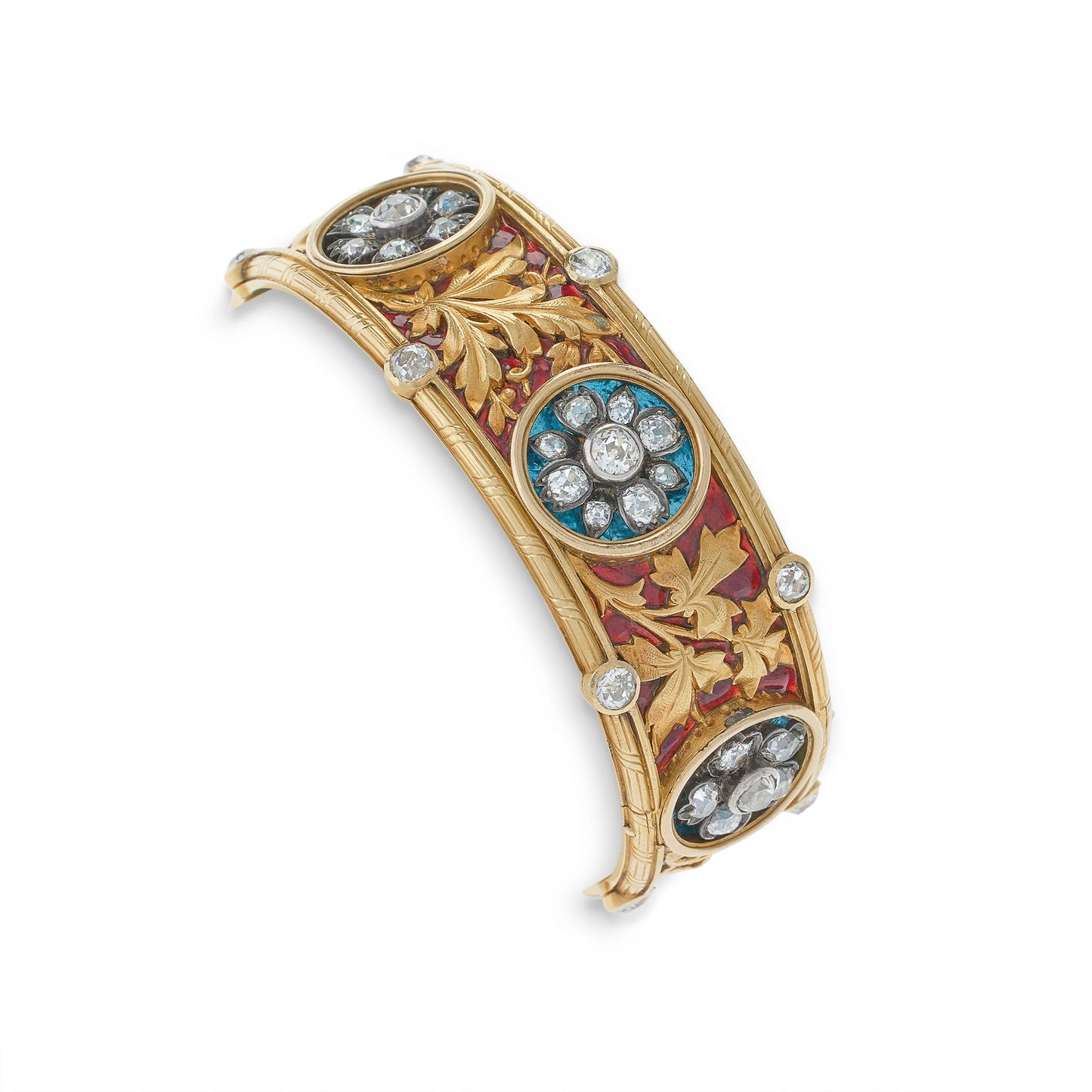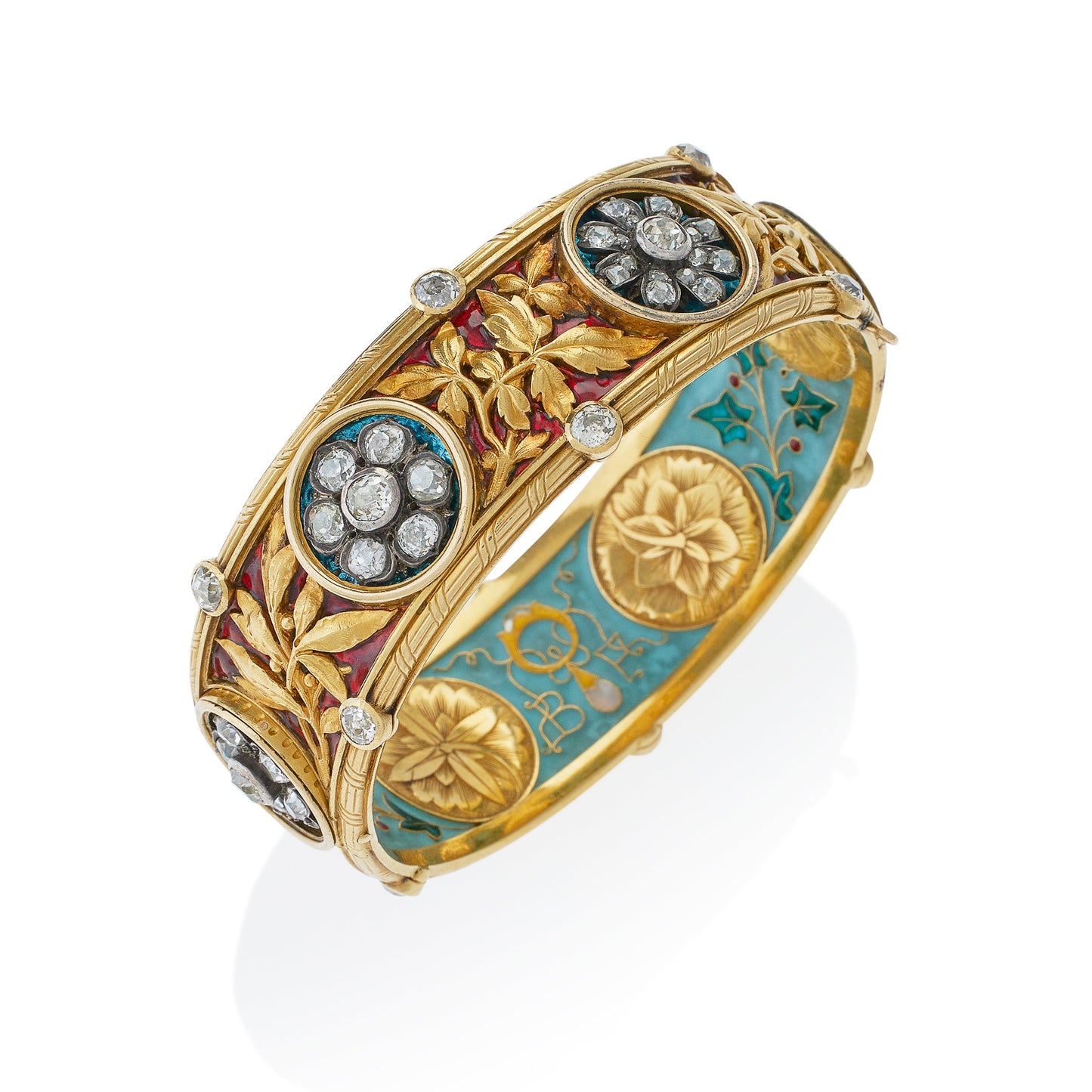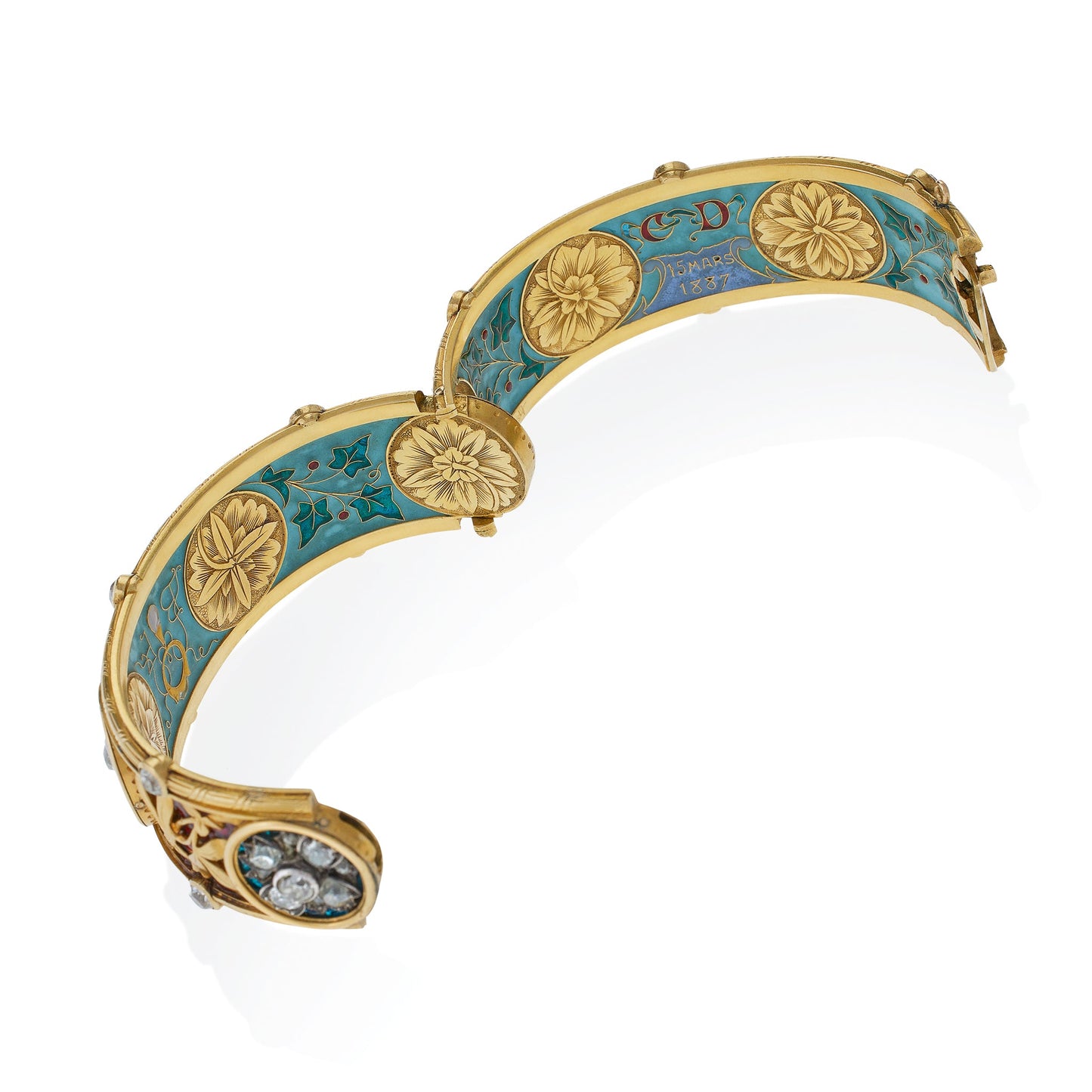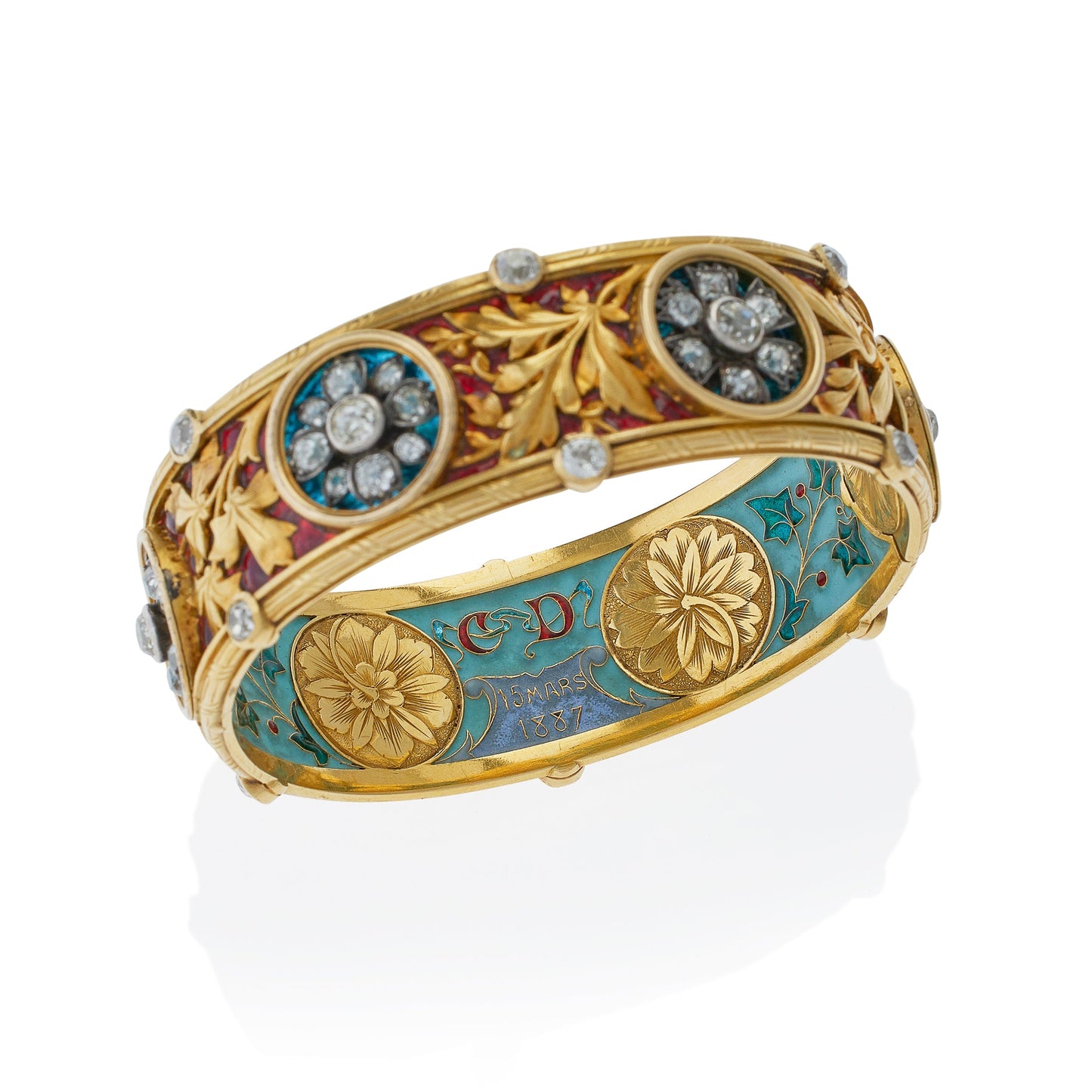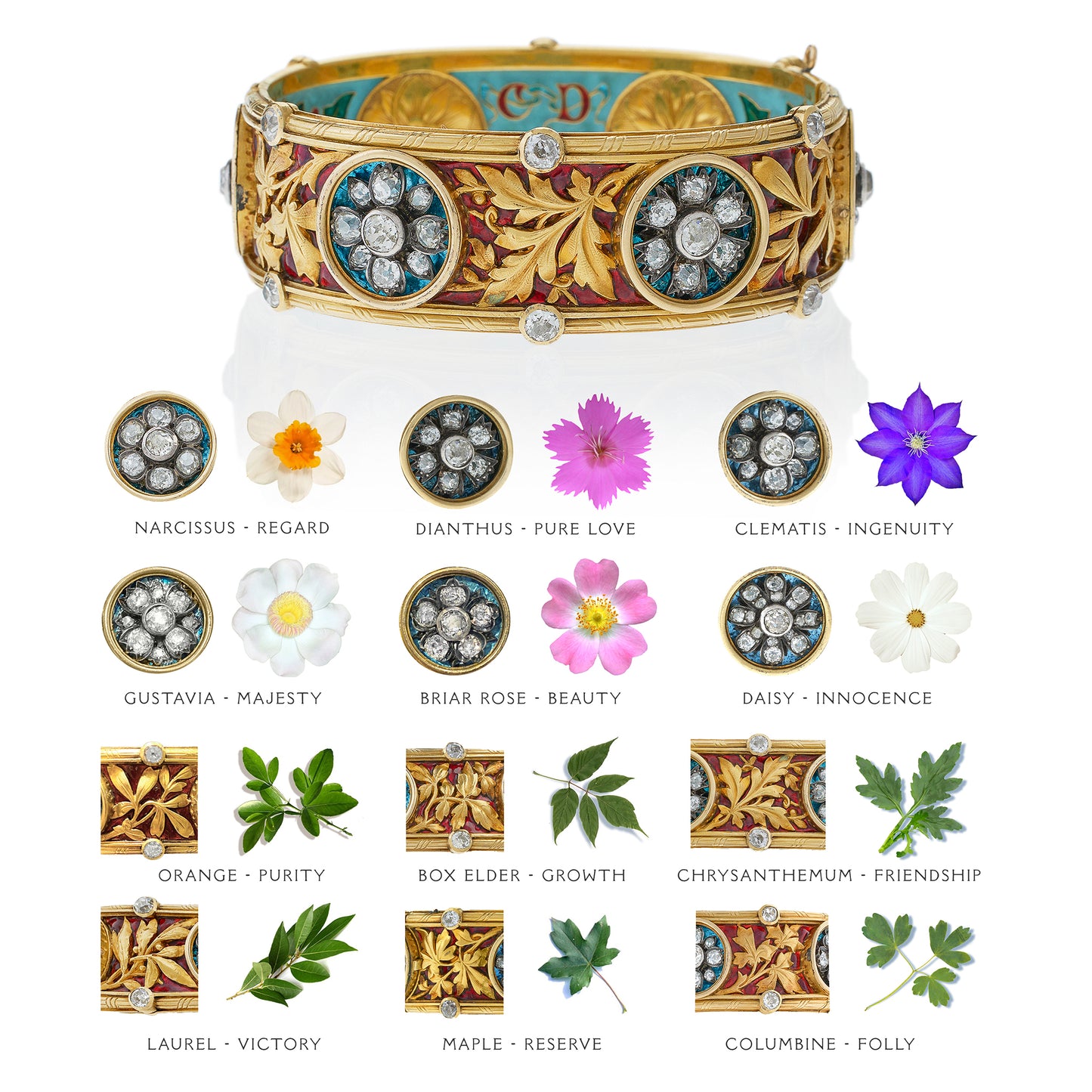Important Bapst & Falize Paris Diamond and Enamel Bangle Bracelet
Made by Bapst and Falize circa 1887, this 18K gold, enamel and diamond bracelet is a magnificent and beautiful specimen of lost jeweler’s arts. The hinged bangle is decorated with medallions depicting six distinct species of blossoms formed of old mine-cut diamonds topping medium relief gold stalks with foliage, some with berries, all chased throughout, surrounded by red translucent enamel sur paillons, with a ridged and incised edge, accented by bezel-set diamonds. The reverse is counter-enameled in opaque sky blue, while each medallion corresponding to the frontal diamond motifs contains a chased relief depiction of the same flower realized in gold, with corresponding stalk and foliage in polychrome cloisonné enamel. This masterpiece, instantly identifiable as the skilled, intellectual work of Lucien Falize and his collaborators, rewards hours of study and admiration for the intricacy and richness of its glowing enamels, gold work, and ideas.
Item #: BA-20528
Artist: Bapst & Falize, Lucien Falize and Germain Bapst, Paris
Country: France
Circa: 1887
Size: 6.50” length x 0.75” width
Materials: 54 old mine-cut diamonds (approximate total weight 5.40 carats); Enamel; 18K gold; Silver-topped gold.
Signed: B & F with Bapst & Falize monogram realized in gold of a ring with a pendant drop tied by a ribbon. With initials CD and date 15 Mars 1887.
Literature: For an enamel bangle bracelet of floral design, in the Indian taste, see Falize: A Dynasty of Jewellers, by Katherine Purcell, p. 81, fig. 117. Additionally, for an image of a paneled bracelet containing a series of botanically defined flowers from this period, see p.80 figure 114, in the aforementioned volume.
Item #: BA-20528
Artist: Bapst & Falize, Lucien Falize and Germain Bapst, Paris
Country: France
Circa: 1887
Size: 6.50” length x 0.75” width
Materials: 54 old mine-cut diamonds (approximate total weight 5.40 carats); Enamel; 18K gold; Silver-topped gold.
Signed: B & F with Bapst & Falize monogram realized in gold of a ring with a pendant drop tied by a ribbon. With initials CD and date 15 Mars 1887.
Literature: For an enamel bangle bracelet of floral design, in the Indian taste, see Falize: A Dynasty of Jewellers, by Katherine Purcell, p. 81, fig. 117. Additionally, for an image of a paneled bracelet containing a series of botanically defined flowers from this period, see p.80 figure 114, in the aforementioned volume.
Lucien Falize (1839-1897) was a second generation jeweler, son of the celebrated Alexis Falize, a brilliant Mellerio-trained designer who had founded his own firm in 1838. Lucien, an eager student of history and literature, had been an academic standout, but was apprenticed into the family business in the 1850s, and worked for many years in close collaboration with his father Alexis, becoming his partner in 1871. Lucien was a devotee of Renaissance and Japanese art. In recognition of his submissions and work for the 1878 Exposition, Lucien won a Grand Prix and Cross of the Legion d’Honneur, distinctions which he modestly confessed “exceeded my wildest dreams”. Historian Henri Vever, a prominent jeweler and contemporary, called Lucien “a scholar, a thinker and an artist”, as well as a man of “impeccable taste and … exceptional talent.”
In 1879, Lucien entered into partnership with Germain Bapst, a gem expert from a prestigious family of royal jewelers. According to Vever, they disagreed about almost everything, but understood each other perfectly. Their work output was relatively small but astonishing, and features in many museum collections. Lucien’s lifelong efforts to innovate and to achieve perfection were relentless. To create these luminous enameled and chased jewels, Falize collaborated with a number of highly skilled engravers and enamelists at the forefront of their respective arts. Such luxury goods - like entirely handmade work in other media from the past - were prohibitively costly to produce. The case of Bapst & Falize, whose jewels were extremely intensive in esoteric arts, was no exception. Despite unabated labor and an abundance of commissions, Bapst & Falize finances were often in precarious state due to the scarcity and high cost of their human capital as well as the countless hours spent perfecting commissions, typically coupled with delays in payment by clients.
Vibrant, translucent enamels such as these were created with the challenging technique of émail paillonnée, in which tiny gold foil specks are placed one at a time between multiple layers of enamel.
In addition to his admiration for the work of Renaissance and Japanese artists, Lucien loved plants for the endless design inspiration they provided, and avidly studied botany. Blossoms such as carnations, forget-me-nots, violets, daisies, buttercups, lily-of-the-valley, blackberry, dandelion, and iris appear in his jewels and decorative objets, as well as more exotic palm leaves, mimosa, and sweet almond, and even humble celery and cabbage. Inspired by Japanese artists' elevated mindfulness of seemingly insignificant, ordinary flora and fauna in nature, Falize wrote that “Even dead wood, in winter, can serve as a model.”
The work of Lucien Falize and Bapst & Falize is held by the Metropolitan Museum of Art, the Los Angeles County Museum of Art, the British Museum, the Musée des Arts Decoratifs, the Musée d’Orsay, and the Petit Palais, among other world institutions. In 2018, the department of European Sculpture and Decorative Arts at Metropolitan Museum of Art received a Lucien Falize enamel bangle bracelet in the Renaissance style, a gift of a distinguished collector. The bracelet complements the Met’s small collection of exquisite enamel work by Falize.
Jewelry by Lucien Falize is rarely to be found on the market.
Lucien Falize (1839-1897) was a second generation jeweler, son of the celebrated Alexis Falize, a brilliant Mellerio-trained designer who had founded his own firm in 1838. Lucien, an eager student of history and literature, had been an academic standout, but was apprenticed into the family business in the 1850s, and worked for many years in close collaboration with his father Alexis, becoming his partner in 1871. Lucien was a devotee of Renaissance and Japanese art. In recognition of his submissions and work for the 1878 Exposition, Lucien won a Grand Prix and Cross of the Legion d’Honneur, distinctions which he modestly confessed “exceeded my wildest dreams”. Historian Henri Vever, a prominent jeweler and contemporary, called Lucien “a scholar, a thinker and an artist”, as well as a man of “impeccable taste and … exceptional talent.”
In 1879, Lucien entered into partnership with Germain Bapst, a gem expert from a prestigious family of royal jewelers. According to Vever, they disagreed about almost everything, but understood each other perfectly. Their work output was relatively small but astonishing, and features in many museum collections. Lucien’s lifelong efforts to innovate and to achieve perfection were relentless. To create these luminous enameled and chased jewels, Falize collaborated with a number of highly skilled engravers and enamelists at the forefront of their respective arts. Such luxury goods - like entirely handmade work in other media from the past - were prohibitively costly to produce. The case of Bapst & Falize, whose jewels were extremely intensive in esoteric arts, was no exception. Despite unabated labor and an abundance of commissions, Bapst & Falize finances were often in precarious state due to the scarcity and high cost of their human capital as well as the countless hours spent perfecting commissions, typically coupled with delays in payment by clients.
Vibrant, translucent enamels such as these were created with the challenging technique of émail paillonnée, in which tiny gold foil specks are placed one at a time between multiple layers of enamel.
In addition to his admiration for the work of Renaissance and Japanese artists, Lucien loved plants for the endless design inspiration they provided, and avidly studied botany. Blossoms such as carnations, forget-me-nots, violets, daisies, buttercups, lily-of-the-valley, blackberry, dandelion, and iris appear in his jewels and decorative objets, as well as more exotic palm leaves, mimosa, and sweet almond, and even humble celery and cabbage. Inspired by Japanese artists' elevated mindfulness of seemingly insignificant, ordinary flora and fauna in nature, Falize wrote that “Even dead wood, in winter, can serve as a model.”
The work of Lucien Falize and Bapst & Falize is held by the Metropolitan Museum of Art, the Los Angeles County Museum of Art, the British Museum, the Musée des Arts Decoratifs, the Musée d’Orsay, and the Petit Palais, among other world institutions. In 2018, the department of European Sculpture and Decorative Arts at Metropolitan Museum of Art received a Lucien Falize enamel bangle bracelet in the Renaissance style, a gift of a distinguished collector. The bracelet complements the Met’s small collection of exquisite enamel work by Falize.
Jewelry by Lucien Falize is rarely to be found on the market.












